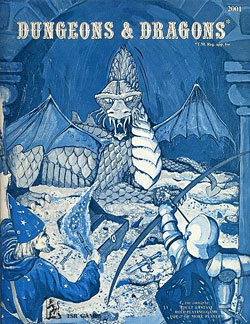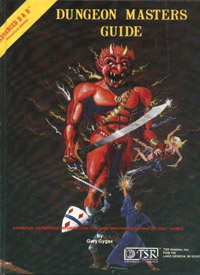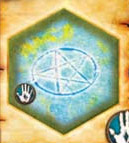05 Mar 08

Many people of my generation are no doubt mourning the passing of an icon from their teenage years, Gary Gygax, co-creator of Dungeons & Dragons, who died this morning, aged 69.
Gygax didn’t create the famous role-playing game on his own–Dave Arneson helped develop the original miniatures wargaming rules Chainmail into the role-playing game we’d recognise today, back in 1974—but his contributions and dedication to the game qualify him as the most popularly recognised ‘father of D&D’.
This could be a curse as well as a blessing, since he copped a lot of flack back in the 80s when psycho Christian groups decided that D&D was responsible for everything from teen suicide and murder to witchcraft. As a teenager I even wrote a long and passionate letter defending the game to the Sixty Minutes programme after they ran a ridiculously misinformed and sensationalised segment about D&D.
As I said then, and I still believe now, playing D&D was a fantastic and enriching experience for any teenager. I’m convinced that being the ‘Game Master’—creating maps, designing character sheets, planning games–put me on the road to be a graphic designer. I shared a lot of great times with friends with whom I’m still close today, and we can still laugh about classic moments that happened during our old games. We adventured in haunted dungeons, foiled smuggler’s plots, fought hordes of ratmen, wandered across post-apocalyptic wastelands, exchanged laser fire on distant worlds, fled from victorian-era ghosts and followed the trail of Lovecraftian cultists. Sure, it was a little tricky juggling the geekiness of role-playing games with being relatively cool, going to parties and getting girlfriends, but I drummed in a band, so that helped.
Though we used to dream about computer versions of our favourite game, I feel like kids now are missing out on all of the wonders their imaginations can conjure. Swordplay with beasties in lifelike computer-generated worlds is all very well, but it can’t beat the totally immersive experience of a good roleplaying game session, which can go way beyond combat to the most complex and involved plots and personalities.
As a matter of fact, we’re planning a game (using the Warhammer Fantasy Roleplaying 2nd Edition system) in a few weeks, for the first time in many years. We may have all entered our forties, but we still have healthy imaginations, and it’s not too difficult for the players to take on their old characters–Lucidius Lavarar, the dissolute and outrageously dressed charlatan and raconteur; Robert Lacy d’Aghuilam duCourt, the arrogant Elven noble and professional duellist; Fatuus Fitzue, the tatty journeyman wizard. Hilarious situations will ensue, vicious combat against horrific foes will be joined, mysteries will be unravelled, and no doubt the world will be saved from the clutches of chaos (again).
We’ll be sure to toast Gary Gygax when we start playing.
Boing Boing interview and video.
LA TImes obituary.
Roleplaying Games Dungeons & Dragons, fantasy
03 Nov 06
Back when I was a little tacker, at about the age of twelve, I discovered Dungeons and Dragons. For me, like many others of my generation, the game was to make a big impact on my life. It sucked up many, many hours, both with friends—sharing adventures in imaginary worlds—and alone—designing worlds and underworlds, painting figures and preparing for the next game. I was always the ‘Dungeon Master’, or game referee, which meant I did a lot of work to prepare the games we played and make the whole game experience as smooth and enjoyable for everyone as possible. In contrast, the players pretty much just had to show up with their characters on a piece of paper (a ‘character sheet’ that I’d lovingly designed) and play.
 As D&D became more popular in the early-80s it started to cop some flack from hysterical fringe groups, due to a few isolated and unfortunate incidents involving obviously unhinged teens taking the game a bit too seriously. Right wing Christians, in particular, attacked the game for its inclusion of demons and devils, and accused it of being a ‘thin end of the wedge’ for Satanic groups. Sniffing a good story, the media latched onto these accusations and ran sensationalist stories about this strange new obsession that was gobbling up the minds of innocent teenagers. I remember in particular one story by the American Sixty Minutes show that was run here in Australia, that focused on a teen homicide supposedly inspired by D&D. In the story, the camera zoomed dramatically into artwork from the game books, focusing on monsters and demons and juxtaposing them with a lurid reconstruction of the crime. Enough to send any parent running terrified into their teen’s room to grab those D&D books and chuck them on the fire.
As D&D became more popular in the early-80s it started to cop some flack from hysterical fringe groups, due to a few isolated and unfortunate incidents involving obviously unhinged teens taking the game a bit too seriously. Right wing Christians, in particular, attacked the game for its inclusion of demons and devils, and accused it of being a ‘thin end of the wedge’ for Satanic groups. Sniffing a good story, the media latched onto these accusations and ran sensationalist stories about this strange new obsession that was gobbling up the minds of innocent teenagers. I remember in particular one story by the American Sixty Minutes show that was run here in Australia, that focused on a teen homicide supposedly inspired by D&D. In the story, the camera zoomed dramatically into artwork from the game books, focusing on monsters and demons and juxtaposing them with a lurid reconstruction of the crime. Enough to send any parent running terrified into their teen’s room to grab those D&D books and chuck them on the fire.
The story so incensed my early-teen self that I wrote the program a carefully composed letter berating them for their sensationism and extolling the virtues of playing D&D and similar games: what about the fact, I asked, that players were being creative, developing their imaginations, learning skills (I still credit those early days with my later interest in graphic design, at which I now I make a living), socialising etc. Why were the actions of a couple of crazy people overshadowing the millions of happy, well-adjusted gamers?
Well, more than twenty-five years have passed and, surprise surprise, millions of teens didn’t grow up to be Satan-worshipping nutjobs. In fact, they mostly grew up to be highly intelligent and often unusually creative adults, and some of them, along with whole new generations, still play role-playing games. Of course, the fringe loonies still rail against the dangers of D&D. Here’s a quote from one of their websites: “Literally millions of young people are unknowingly participating in genuine occult practices and opening the doors for demons to enter their bodies through this seemingly innocent game.” Uh huh … riiiiight.
 So what reminded me of this kind of intolerance? The upcoming game BattleLore by Days of Wonder has a terrain piece called a ‘Magic Pentacle’ that features a pentacle symbol. To my amazement, some people on public forums have expressed concern that the use of such a symbol will offend some Christian sensibilities and possibly lead to some sort of ‘backlash’ for the company; or that it was a bad marketing decision to include such a symbol.
So what reminded me of this kind of intolerance? The upcoming game BattleLore by Days of Wonder has a terrain piece called a ‘Magic Pentacle’ that features a pentacle symbol. To my amazement, some people on public forums have expressed concern that the use of such a symbol will offend some Christian sensibilities and possibly lead to some sort of ‘backlash’ for the company; or that it was a bad marketing decision to include such a symbol.
Leaving aside for the moment that the pentacle is a symbol that goes back to ancient times and was only co-opted by occult groups in the last century; or that Days of Wonder publishes in several countries, not just America, where the vast majority of this kind of criticism comes. Instead I just have to shake my head in slack-jawed amazement at the kind of people who go through life with beliefs so intolerant, with world-views so narrow, with ignorance so complete, as to be offended or angered by the use of a pentacle symbol in a fantasy boardgame.
Save us from the small- and narrow-minded, those who strive to restrict the boundless possibilities of the imagination to the claustrophobic confines of the religious fanatic. Tonight my girl and I sat down and watched The Lord of the Rings: The Fellowship of the Ring again together. I still had to hold back tears. Imagine if Tolkien had been forced to take out the balrog because it was too much like a demon, or Sauron himself because he offended right-wing conservative Christians with his similarities to the Devil. Let’s get rid of those witches in Grimm’s Fairy Tales shall we? Look, while we’re at it, Edgar Allan Poe wrote some occult stories … imagine how grey the world would be if we were not allowed to play imaginative games, or read stories or see films, until they’d been approved by some self-appointed, self-righteous body who had decided they had the right to determine what was a threat to our morality? There are always those who want to stifle creativity, sanitise stories, censor art. What a terrible shame their imaginations have dried up from disuse.
Anyway, all that aside … repeat after me people: it’s just a game.
Opinions Dungeons & Dragons


 As D&D became more popular in the early-80s it started to cop some flack from hysterical fringe groups, due to a few isolated and unfortunate incidents involving obviously unhinged teens taking the game a bit too seriously. Right wing Christians, in particular, attacked the game for its inclusion of demons and devils, and accused it of being a ‘thin end of the wedge’ for Satanic groups. Sniffing a good story, the media latched onto these accusations and ran sensationalist stories about this strange new obsession that was gobbling up the minds of innocent teenagers. I remember in particular one story by the American Sixty Minutes show that was run here in Australia, that focused on a teen homicide supposedly inspired by D&D. In the story, the camera zoomed dramatically into artwork from the game books, focusing on monsters and demons and juxtaposing them with a lurid reconstruction of the crime. Enough to send any parent running terrified into their teen’s room to grab those D&D books and chuck them on the fire.
As D&D became more popular in the early-80s it started to cop some flack from hysterical fringe groups, due to a few isolated and unfortunate incidents involving obviously unhinged teens taking the game a bit too seriously. Right wing Christians, in particular, attacked the game for its inclusion of demons and devils, and accused it of being a ‘thin end of the wedge’ for Satanic groups. Sniffing a good story, the media latched onto these accusations and ran sensationalist stories about this strange new obsession that was gobbling up the minds of innocent teenagers. I remember in particular one story by the American Sixty Minutes show that was run here in Australia, that focused on a teen homicide supposedly inspired by D&D. In the story, the camera zoomed dramatically into artwork from the game books, focusing on monsters and demons and juxtaposing them with a lurid reconstruction of the crime. Enough to send any parent running terrified into their teen’s room to grab those D&D books and chuck them on the fire. So what reminded me of this kind of intolerance? The upcoming game
So what reminded me of this kind of intolerance? The upcoming game
Recent Comments